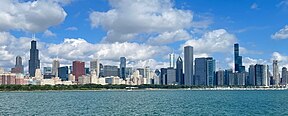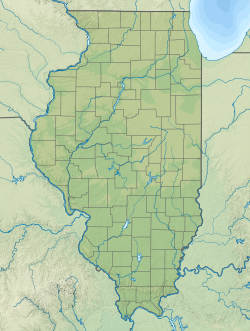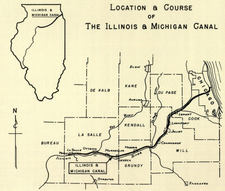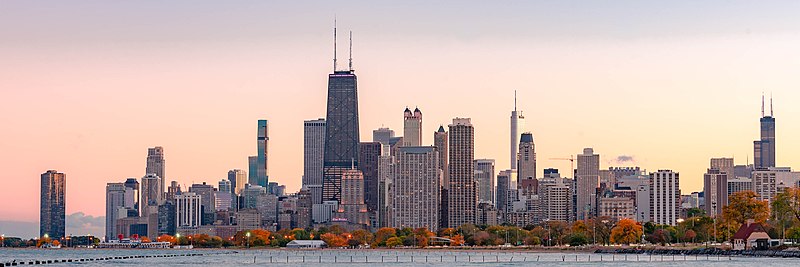
A | B | C | D | E | F | G | H | CH | I | J | K | L | M | N | O | P | Q | R | S | T | U | V | W | X | Y | Z | 0 | 1 | 2 | 3 | 4 | 5 | 6 | 7 | 8 | 9
Chicago | |
|---|---|
|
| |
| Etymology: Miami-Illinois: shikaakwa ('wild onion' or 'wild garlic') | |
| Nickname(s): Windy City and others | |
| Motto(s): Latin: Urbs in Horto (City in a Garden); I Will | |
 Interactive map of Chicago | |
| Coordinates: 41°52′55″N 87°37′40″W / 41.88194°N 87.62778°W[1] | |
| Country | United States |
| State | Illinois |
| Counties | Cook and DuPage |
| Settled | c. 1780 |
| Incorporated (town) | August 12, 1833 |
| Incorporated (city) | March 4, 1837 |
| Founded by | Jean Baptiste Point du Sable |
| Government | |
| • Type | Mayor–council |
| • Body | Chicago City Council |
| • Mayor | Brandon Johnson (D) |
| • City Clerk | Anna Valencia (D) |
| • City Treasurer | Melissa Conyears-Ervin (D) |
| Area | |
| • City | 234.53 sq mi (607.44 km2) |
| • Land | 227.73 sq mi (589.82 km2) |
| • Water | 6.80 sq mi (17.62 km2) |
| Elevation [1] (mean) | 597.18 ft (182.02 m) |
| Highest elevation – near Blue Island | 672 ft (205 m) |
| Lowest elevation – at Lake Michigan | 578 ft (176 m) |
| Population | |
| • City | 2,746,388 |
| • Estimate (2022)[3] | 2,665,039 |
| • Rank | |
| • Density | 12,059.84/sq mi (4,656.33/km2) |
| • Urban | 8,671,746 (US: 3rd) |
| • Urban density | 3,709.2/sq mi (1,432.1/km2) |
| • Metro | 9,618,502 (US: 3rd) |
| Demonym | Chicagoan |
| GDP | |
| • Chicago (MSA) | $832.9 billion (2022) |
| Time zone | UTC−06:00 (CST) |
| • Summer (DST) | UTC−05:00 (CDT) |
| ZIP Code prefixes | 606xx, 607xx, 608xx |
| Area codes | 312, 773, 872 |
| FIPS code | 17-14000 |
| GNIS feature ID | 0428803 |
| Website | chicago |
Chicago[a] is the most populous city in the U.S. state of Illinois and in the Midwestern United States. With a population of 2,746,388 in the 2020 census,[8] it is the third-most populous city in the United States after New York City and Los Angeles. As the seat of Cook County, the second-most populous county in the U.S., Chicago is the center of the Chicago metropolitan area, often colloquially called "Chicagoland" and home to 9.6 million residents.
Located on the shore of Lake Michigan, Chicago was incorporated as a city in 1837 near a portage between the Great Lakes and the Mississippi River watershed. It grew rapidly in the mid-19th century.[9][10] In 1871, the Great Chicago Fire destroyed several square miles and left more than 100,000 homeless,[11] but Chicago's population continued to grow.[10] Chicago made noted contributions to urban planning and architecture, such as the Chicago School, the development of the City Beautiful Movement, and the steel-framed skyscraper.[12][13]
Chicago is an international hub for finance, culture, commerce, industry, education, technology, telecommunications, and transportation. It has the largest and most diverse derivatives market in the world, generating 20% of all volume in commodities and financial futures alone.[14] O'Hare International Airport is routinely ranked among the world's top six busiest airports by passenger traffic,[15] and the region is also the nation's railroad hub.[16] The Chicago area has one of the highest gross domestic products (GDP) of any urban region in the world, generating $689 billion in 2018.[17] Chicago's economy is diverse, with no single industry employing more than 14% of the workforce.[14]
Chicago is a major destination for tourism, including visitors to its cultural institutions, and Lake Michigan beaches. Chicago's culture has contributed much to the visual arts, literature, film, theater, comedy (especially improvisational comedy), food, dance, and music (particularly jazz, blues, soul, hip-hop, gospel,[18] and electronic dance music, including house music). Chicago is home to the Chicago Symphony Orchestra and the Lyric Opera of Chicago, while the Art Institute of Chicago provides an influential visual arts museum and art school. The Chicago area also hosts the University of Chicago, Northwestern University, and the University of Illinois Chicago, among other institutions of learning. Professional sports in Chicago include all major professional leagues, including two Major League Baseball teams.
Etymology and nicknames
The name Chicago is derived from a French rendering of the indigenous Miami-Illinois word shikaakwa for a wild relative of the onion; it is known to botanists as Allium tricoccum and known more commonly as "ramps". The first known reference to the site of the current city of Chicago as "Checagou" was by Robert de LaSalle around 1679 in a memoir.[19] Henri Joutel, in his journal of 1688, noted that the eponymous wild "garlic" grew profusely in the area.[20] According to his diary of late September 1687:
... when we arrived at the said place called "Chicagou" which, according to what we were able to learn of it, has taken this name because of the quantity of garlic which grows in the forests in this region.[20]
The city has had several nicknames throughout its history, such as the Windy City, Chi-Town, Second City, and City of the Big Shoulders.[21]
History
Beginnings

In the mid-18th century, the area was inhabited by the Potawatomi, an indigenous tribe who had succeeded the Miami and Sauk and Fox peoples in this region.[22]

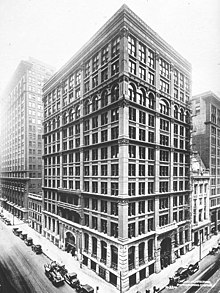
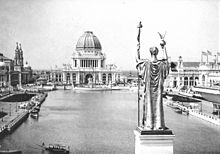
The first known permanent settler in Chicago was trader Jean Baptiste Point du Sable. Du Sable was of African descent, perhaps born in the French colony of Saint-Domingue (Haiti), and established the settlement in the 1780s. He is commonly known as the "Founder of Chicago".[23][24][25]
In 1795, following the victory of the new United States in the Northwest Indian War, an area that was to be part of Chicago was turned over to the U.S. for a military post by native tribes in accordance with the Treaty of Greenville. In 1803, the U.S. Army constructed Fort Dearborn, which was destroyed during the War of 1812 in the Battle of Fort Dearborn by the Potawatomi before being later rebuilt.[26]
After the War of 1812, the Ottawa, Ojibwe, and Potawatomi tribes ceded additional land to the United States in the 1816 Treaty of St. Louis. The Potawatomi were forcibly removed from their land after the 1833 Treaty of Chicago and sent west of the Mississippi River as part of the federal policy of Indian removal.[27][28][29]
19th century
On August 12, 1833, the Town of Chicago was organized with a population of about 200.[29] Within seven years it grew to more than 6,000 people. On June 15, 1835, the first public land sales began with Edmund Dick Taylor as Receiver of Public Monies. The City of Chicago was incorporated on Saturday, March 4, 1837,[30] and for several decades was the world's fastest-growing city.[31]
As the site of the Chicago Portage,[32] the city became an important transportation hub between the eastern and western United States. Chicago's first railway, Galena and Chicago Union Railroad, and the Illinois and Michigan Canal opened in 1848. The canal allowed steamboats and sailing ships on the Great Lakes to connect to the Mississippi River.[33][34][35][36]
A flourishing economy brought residents from rural communities and immigrants from abroad. Manufacturing and retail and finance sectors became dominant, influencing the American economy.[37] The Chicago Board of Trade (established 1848) listed the first-ever standardized "exchange-traded" forward contracts, which were called futures contracts.[38]
In the 1850s, Chicago gained national political prominence as the home of Senator Stephen Douglas, the champion of the Kansas–Nebraska Act and the "popular sovereignty" approach to the issue of the spread of slavery.[39] These issues also helped propel another Illinoisan, Abraham Lincoln, to the national stage. Lincoln was nominated in Chicago for U.S. president at the 1860 Republican National Convention, which was held in a purpose-built auditorium called the Wigwam. He defeated Douglas in the general election, and this set the stage for the American Civil War.
To accommodate rapid population growth and demand for better sanitation, the city improved its infrastructure. In February 1856, Chicago's Common Council approved Chesbrough's plan to build the United States' first comprehensive sewerage system.[40] The project raised much of central Chicago to a new grade with the use of jackscrews for raising buildings.[41] While elevating Chicago, and at first improving the city's health, the untreated sewage and industrial waste now flowed into the Chicago River, and subsequently into Lake Michigan, polluting the city's primary freshwater source.
The city responded by tunneling two miles (3.2 km) out into Lake Michigan to newly built water cribs. In 1900, the problem of sewage contamination was largely resolved when the city completed a major engineering feat. It reversed the flow of the Chicago River so that the water flowed away from Lake Michigan rather than into it. This project began with the construction and improvement of the Illinois and Michigan Canal, and was completed with the Chicago Sanitary and Ship Canal that connects to the Illinois River, which flows into the Mississippi River.[42][43][44]
In 1871, the Great Chicago Fire destroyed an area about 4 miles (6.4 km) long and 1-mile (1.6 km) wide, a large section of the city at the time.[45][46][47] Much of the city, including railroads and stockyards, survived intact,[48] and from the ruins of the previous wooden structures arose more modern constructions of steel and stone. These set a precedent for worldwide construction.[49][50] During its rebuilding period, Chicago constructed the world's first skyscraper in 1885, using steel-skeleton construction.[51][52]
The city grew significantly in size and population by incorporating many neighboring townships between 1851 and 1920, with the largest annexation happening in 1889, with five townships joining the city, including the Hyde Park Township, which now comprises most of the South Side of Chicago and the far southeast of Chicago, and the Jefferson Township, which now makes up most of Chicago's Northwest Side.[53] The desire to join the city was driven by municipal services that the city could provide its residents.
Chicago's flourishing economy attracted huge numbers of new immigrants from Europe and migrants from the Eastern United States. Of the total population in 1900, more than 77% were either foreign-born or born in the United States of foreign parentage. Germans, Irish, Poles, Swedes, and Czechs made up nearly two-thirds of the foreign-born population (by 1900, whites were 98.1% of the city's population).[54][55]
Labor conflicts followed the industrial boom and the rapid expansion of the labor pool, including the Haymarket affair on May 4, 1886, and in 1894 the Pullman Strike. Anarchist and socialist groups played prominent roles in creating very large and highly organized labor actions. Concern for social problems among Chicago's immigrant poor led Jane Addams and Ellen Gates Starr to found Hull House in 1889.[56] Programs that were developed there became a model for the new field of social work.[57]
During the 1870s and 1880s, Chicago attained national stature as the leader in the movement to improve public health. City laws and later, state laws that upgraded standards for the medical profession and fought urban epidemics of cholera, smallpox, and yellow fever were both passed and enforced. These laws became templates for public health reform in other cities and states.[58]
The city established many large, well-landscaped municipal parks, which also included public sanitation facilities. The chief advocate for improving public health in Chicago was John H. Rauch, M.D. Rauch established a plan for Chicago's park system in 1866. He created Lincoln Park by closing a cemetery filled with shallow graves, and in 1867, in response to an outbreak of cholera he helped establish a new Chicago Board of Health. Ten years later, he became the secretary and then the president of the first Illinois State Board of Health, which carried out most of its activities in Chicago.[59]
In the 1800s, Chicago became the nation's railroad hub, and by 1910 over 20 railroads operated passenger service out of six different downtown terminals.[60][61] In 1883, Chicago's railway managers needed a general time convention, so they developed the standardized system of North American time zones.[62] This system for telling time spread throughout the continent.
In 1893, Chicago hosted the World's Columbian Exposition on former marshland at the present location of Jackson Park. The Exposition drew 27.5 million visitors, and is considered the most influential world's fair in history.[63][64] The University of Chicago, formerly at another location, moved to the same South Side location in 1892. The term "midway" for a fair or carnival referred originally to the Midway Plaisance, a strip of park land that still runs through the University of Chicago campus and connects the Washington and Jackson Parks.[65][66]
20th and 21st centuries
1900 to 1939
During World War I and the 1920s there was a major expansion in industry. The availability of jobs attracted African Americans from the Southern United States. Between 1910 and 1930, the African American population of Chicago increased dramatically, from 44,103 to 233,903.[67] This Great Migration had an immense cultural impact, called the Chicago Black Renaissance, part of the New Negro Movement, in art, literature, and music.[68] Continuing racial tensions and violence, such as the Chicago race riot of 1919, also occurred.[69]
The ratification of the 18th amendment to the Constitution in 1919 made the production and sale (including exportation) of alcoholic beverages illegal in the United States. This ushered in the beginning of what is known as the gangster era, a time that roughly spans from 1919 until 1933 when Prohibition was repealed. The 1920s saw gangsters, including Al Capone, Dion O'Banion, Bugs Moran and Tony Accardo battle law enforcement and each other on the streets of Chicago during the Prohibition era.[70] Chicago was the location of the infamous St. Valentine's Day Massacre in 1929, when Al Capone sent men to gun down members of a rival gang, North Side, led by Bugs Moran.[71]
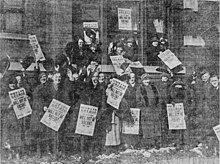
From 1920 to 1921, the city was affected by a series of tenant rent strikes in it. Which lead to the formation of the Chicago Tenants Protective association, passage of the Kessenger tenant laws, and of a heat ordinance that legally required flats to be kept above 68 °F during winter months by landlords.[72][73][74][75][76][77]
Chicago was the first American city to have a homosexual-rights organization. The organization, formed in 1924, was called the Society for Human Rights. It produced the first American publication for homosexuals, Friendship and Freedom. Police and political pressure caused the organization to disband.[78]

The Great Depression brought unprecedented suffering to Chicago, in no small part due to the city's heavy reliance on heavy industry. Notably, industrial areas on the south side and neighborhoods lining both branches of the Chicago River were devastated; by 1933 over 50% of industrial jobs in the city had been lost, and unemployment rates amongst blacks and Mexicans in the city were over 40%. The Republican political machine in Chicago was utterly destroyed by the economic crisis, and every mayor since 1931 has been a Democrat.[79]
From 1928 to 1933, the city witnessed a tax revolt, and the city was unable to meet payroll or provide relief efforts. The fiscal crisis was resolved by 1933, and at the same time, federal relief funding began to flow into Chicago.[79] Chicago was also a hotbed of labor activism, with Unemployed Councils contributing heavily in the early depression to create solidarity for the poor and demand relief; these organizations were created by socialist and communist groups. By 1935 the Workers Alliance of America begun organizing the poor, workers, the unemployed. In the spring of 1937 Republic Steel Works witnessed the Memorial Day massacre of 1937 in the neighborhood of East Side.
In 1933, Chicago Mayor Anton Cermak was fatally wounded in Miami, Florida, during a failed assassination attempt on President-elect Franklin D. Roosevelt. In 1933 and 1934, the city celebrated its centennial by hosting the Century of Progress International Exposition World's Fair.[80] The theme of the fair was technological innovation over the century since Chicago's founding.[81]
1940 to 1979

During World War II, the city of Chicago alone produced more steel than the United Kingdom every year from 1939 – 1945, and more than Nazi Germany from 1943 – 1945.[82]
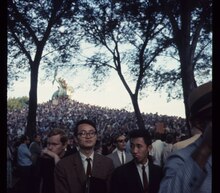
The Great Migration, which had been on pause due to the Depression, resumed at an even faster pace in the second wave, as hundreds of thousands of blacks from the South arrived in the city to work in the steel mills, railroads, and shipping yards.[83]
On December 2, 1942, physicist Enrico Fermi conducted the world's first controlled nuclear reaction at the University of Chicago as part of the top-secret Manhattan Project. This led to the creation of the atomic bomb by the United States, which it used in World War II in 1945.[84]
Mayor Richard J. Daley, a Democrat, was elected in 1955, in the era of machine politics. In 1956, the city conducted its last major expansion when it annexed the land under O'Hare airport, including a small portion of DuPage County.[85]
By the 1960s, white residents in several neighborhoods left the city for the suburban areas – in many American cities, a process known as white flight – as Blacks continued to move beyond the Black Belt.[86] While home loan discriminatory redlining against blacks continued, the real estate industry practiced what became known as blockbusting, completely changing the racial composition of whole neighborhoods.[87] Structural changes in industry, such as globalization and job outsourcing, caused heavy job losses for lower-skilled workers. At its peak during the 1960s, some 250,000 workers were employed in the steel industry in Chicago, but the steel crisis of the 1970s and 1980s reduced this number to just 28,000 in 2015. In 1966, Martin Luther King Jr. and Albert Raby led the Chicago Freedom Movement, which culminated in agreements between Mayor Richard J. Daley and the movement leaders.[88]
Two years later, the city hosted the tumultuous 1968 Democratic National Convention, which featured physical confrontations both inside and outside the convention hall, with anti-war protesters, journalists and bystanders being beaten by police.[89] Major construction projects, including the Sears Tower (now known as the Willis Tower, which in 1974 became the world's tallest building), University of Illinois at Chicago, McCormick Place, and O'Hare International Airport, were undertaken during Richard J. Daley's tenure.[90] In 1979, Jane Byrne, the city's first female mayor, was elected. She was notable for temporarily moving into the crime-ridden Cabrini-Green housing project and for leading Chicago's school system out of a financial crisis.[91]
1980 to present
In 1983, Harold Washington became the first black mayor of Chicago. Washington's first term in office directed attention to poor and previously neglected minority neighborhoods. He was re‑elected in 1987 but died of a heart attack soon after.[92] Washington was succeeded by 6th ward alderperson Eugene Sawyer, who was elected by the Chicago City Council and served until a special election.
Richard M. Daley, son of Richard J. Daley, was elected in 1989. His accomplishments included improvements to parks and creating incentives for sustainable development, as well as closing Meigs Field in the middle of the night and destroying the runways. After successfully running for re-election five times, and becoming Chicago's longest-serving mayor, Richard M. Daley declined to run for a seventh term.[93][94]
In 1992, a construction accident near the Kinzie Street Bridge produced a breach connecting the Chicago River to a tunnel below, which was part of an abandoned freight tunnel system extending throughout the downtown Loop district. The tunnels filled with 250 million US gallons (1,000,000 m3) of water, affecting buildings throughout the district and forcing a shutdown of electrical power.[95] The area was shut down for three days and some buildings did not reopen for weeks; losses were estimated at $1.95 billion.[95]
On February 23, 2011, Rahm Emanuel, a former White House Chief of Staff and member of the House of Representatives, won the mayoral election.[96] Emanuel was sworn in as mayor on May 16, 2011, and won re-election in 2015.[97] Lori Lightfoot, the city's first African American woman mayor and its first openly LGBTQ mayor, was elected to succeed Emanuel as mayor in 2019.[98] All three city-wide elective offices were held by women (and women of color) for the first time in Chicago history: in addition to Lightfoot, the city clerk was Anna Valencia and the city treasurer was Melissa Conyears-Ervin.[99]
On May 15, 2023, Brandon Johnson assumed office as the 57th mayor of Chicago.
Geography
Topography
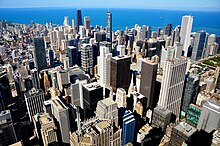
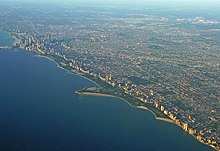

Chicago is located in northeastern Illinois on the southwestern shores of freshwater Lake Michigan. It is the principal city in the Chicago metropolitan area, situated in both the Midwestern United States and the Great Lakes region. The city rests on a continental divide at the site of the Chicago Portage, connecting the Mississippi River and the Great Lakes watersheds. In addition to it lying beside Lake Michigan, two rivers—the Chicago River in downtown and the Calumet River in the industrial far South Side—flow either entirely or partially through the city.[100][101]
Chicago's history and economy are closely tied to its proximity to Lake Michigan. While the Chicago River historically handled much of the region's waterborne cargo, today's huge lake freighters use the city's Lake Calumet Harbor on the South Side. The lake also provides another positive effect: moderating Chicago's climate, making waterfront neighborhoods slightly warmer in winter and cooler in summer.[102]
When Chicago was founded in 1837, most of the early building was around the mouth of the Chicago River, as can be seen on a map of the city's original 58 blocks.[103] The overall grade of the city's central, built-up areas is relatively consistent with the natural flatness of its overall natural geography, generally exhibiting only slight differentiation otherwise. The average land elevation is 579 ft (176.5 m) above sea level. While measurements vary somewhat,[104] the lowest points are along the lake shore at 578 ft (176.2 m), while the highest point, at 672 ft (205 m), is the morainal ridge of Blue Island in the city's far south side.[105]
Lake Shore Drive runs adjacent to a large portion of Chicago's waterfront. Some of the parks along the waterfront include Lincoln Park, Grant Park, Burnham Park, and Jackson Park. There are 24 public beaches across 26 miles (42 km) of the waterfront.[106] Landfill extends into portions of the lake providing space for Navy Pier, Northerly Island, the Museum Campus, and large portions of the McCormick Place Convention Center. Most of the city's high-rise commercial and residential buildings are close to the waterfront.
An informal name for the entire Chicago metropolitan area is "Chicagoland", which generally means the city and all its suburbs, though different organizations have slightly different definitions.[107][108][109]
Communities
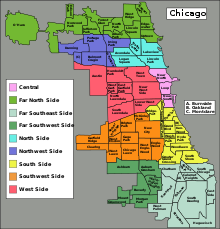
Major sections of the city include the central business district, called the Loop, and the North, South, and West Sides.[110] The three sides of the city are represented on the Flag of Chicago by three horizontal white stripes.[111] The North Side is the most-densely-populated residential section of the city, and many high-rises are located on this side of the city along the lakefront.[112] The South Side is the largest section of the city, encompassing roughly 60% of the city's land area. The South Side contains most of the facilities of the Port of Chicago.[113]
In the late-1920s, sociologists at the University of Chicago subdivided the city into 77 distinct community areas, which can further be subdivided into over 200 informally defined neighborhoods.[114][115]
Streetscape
Chicago's streets were laid out in a street grid that grew from the city's original townsite plot, which was bounded by Lake Michigan on the east, North Avenue on the north, Wood Street on the west, and 22nd Street on the south.[116] Streets following the Public Land Survey System section lines later became arterial streets in outlying sections. As new additions to the city were platted, city ordinance required them to be laid out with eight streets to the mile in one direction and sixteen in the other direction, about one street per 200 meters in one direction and one street per 100 meters in the other direction. The grid's regularity provided an efficient means of developing new real estate property. A scattering of diagonal streets, many of them originally Native American trails, also cross the city (Elston, Milwaukee, Ogden, Lincoln, etc.). Many additional diagonal streets were recommended in the Plan of Chicago, but only the extension of Ogden Avenue was ever constructed.[117]
In 2016, Chicago was ranked the sixth-most walkable large city in the United States.[118] Many of the city's residential streets have a wide patch of grass or trees between the street and the sidewalk itself. This helps to keep pedestrians on the sidewalk further away from the street traffic. Chicago's Western Avenue is the longest continuous urban street in the world.[119] Other notable streets include Michigan Avenue, State Street, 95th Street, Cicero Avenue, Clark Street, and Belmont Avenue. The City Beautiful movement inspired Chicago's boulevards and parkways.[120]
Architecture
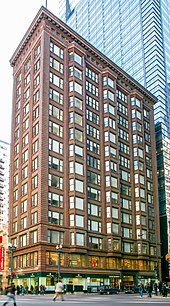
The destruction caused by the Great Chicago Fire led to the largest building boom in the history of the nation. In 1885, the first steel-framed high-rise building, the Home Insurance Building, rose in the city as Chicago ushered in the skyscraper era,[52] which would then be followed by many other cities around the world.[121] Today, Chicago's skyline is among the world's tallest and densest.[122]
Some of the United States' tallest towers are located in Chicago; Willis Tower (formerly Sears Tower) is the second tallest building in the Western Hemisphere after One World Trade Center, and Trump International Hotel and Tower is the third tallest in the country.[123] The Loop's historic buildings include the Chicago Board of Trade Building, the Fine Arts Building, 35 East Wacker, and the Chicago Building, 860-880 Lake Shore Drive Apartments by Mies van der Rohe. Many other architects have left their impression on the Chicago skyline such as Daniel Burnham, Louis Sullivan, Charles B. Atwood, John Root, and Helmut Jahn.[124][125]
The Merchandise Mart, once first on the list of largest buildings in the world, currently listed as 44th-largest 2013 as September 9, 2013, had its own zip code until 2008, and stands near the junction of the North and South branches of the Chicago River.[126] Presently, the four tallest buildings in the city are Willis Tower (formerly the Sears Tower, also a building with its own zip code), Trump International Hotel and Tower, the Aon Center (previously the Standard Oil Building), and the John Hancock Center. Industrial districts, such as some areas on the South Side, the areas along the Chicago Sanitary and Ship Canal, and the Northwest Indiana area are clustered.[127]
Chicago gave its name to the Chicago School and was home to the Prairie School, two movements in architecture.[128] Multiple kinds and scales of houses, townhouses, condominiums, and apartment buildings can be found throughout Chicago. Large swaths of the city's residential areas away from the lake are characterized by brick bungalows built from the early 20th century through the end of World War II. Chicago is also a prominent center of the Polish Cathedral style of church architecture. The Chicago suburb of Oak Park was home to famous architect Frank Lloyd Wright, who had designed The Robie House located near the University of Chicago.[129][130]
A popular tourist activity is to take an architecture boat tour along the Chicago River.[131]
Monuments and public art

Chicago is famous for its outdoor public art with donors establishing funding for such art as far back as Benjamin Ferguson's 1905 trust.[132] A number of Chicago's public art works are by modern figurative artists. Among these are Chagall's Four Seasons; the Chicago Picasso; Miro's Chicago; Calder's Flamingo; Oldenburg's Batcolumn; Moore's Large Interior Form, 1953-54, Man Enters the Cosmos and Nuclear Energy; Dubuffet's Monument with Standing Beast, Abakanowicz's Agora; and, Anish Kapoor's Cloud Gate which has become an icon of the city. Some events which shaped the city's history have also been memorialized by art works, including the Great Northern Migration (Saar) and the centennial of statehood for Illinois. Finally, two fountains near the Loop also function as monumental works of art: Plensa's Crown Fountain as well as Burnham and Bennett's Buckingham Fountain.[133][134]
Climate
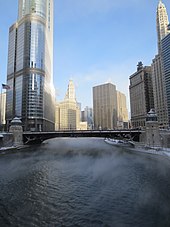
The city lies within the typical hot-summer humid continental climate (Köppen: Dfa), and experiences four distinct seasons.[135][136][137] Summers are hot and humid, with frequent heat waves. The July daily average temperature is 75.4 °F (24.1 °C), with afternoon temperatures peaking at 84.5 °F (29.2 °C). In a normal summer, temperatures reach at least 90 °F (32 °C) on 17 days, with lakefront locations staying cooler when winds blow off the lake. Winters are relatively cold and snowy. Blizzards do occur, such as in winter 2011.[138] There are many sunny but cold days. The normal winter high from December through March is about 36 °F (2 °C). January and February are the coldest months. A polar vortex in January 2019 nearly broke the city's cold record of −27 °F (−33 °C), which was set on January 20, 1985.[139][140][141] Measurable snowfall can continue through the first or second week of April.[142]
Spring and autumn are mild, short seasons, typically with low humidity. Dew point temperatures in the summer range from an average of 55.8 °F (13.2 °C) in June to 61.7 °F (16.5 °C) in July.[143] They can reach nearly 80 °F (27 °C), such as during the July 2019 heat wave. The city lies within USDA plant hardiness zone 6a, transitioning to 5b in the suburbs.[144]
According to the National Weather Service, Chicago's highest official temperature reading of 105 °F (41 °C) was recorded on July 24, 1934.[145] Midway Airport reached 109 °F (43 °C) one day prior and recorded a heat index of 125 °F (52 °C) during the 1995 heatwave.[146] The lowest official temperature of −27 °F (−33 °C) was recorded on January 20, 1985, at O'Hare Airport.[143][146] Most of the city's rainfall is brought by thunderstorms, averaging 38 a year. The region is prone to severe thunderstorms during the spring and summer which can produce large hail, damaging winds, and occasionally tornadoes.[147]
Like other major cities, Chicago experiences an urban heat island, making the city and its suburbs milder than surrounding rural areas, especially at night and in winter. The proximity to Lake Michigan tends to keep the Chicago lakefront somewhat cooler in summer and less brutally cold in winter than inland parts of the city and suburbs away from the lake.[148] Northeast winds from wintertime cyclones departing south of the region sometimes bring the city lake-effect snow.[149]
| Climate data for Chicago (Midway Airport), 1991–2020 normals,[b] extremes 1928–present | |||||||||||||
|---|---|---|---|---|---|---|---|---|---|---|---|---|---|
| Month | Jan | Feb | Mar | Apr | May | Jun | Jul | Aug | Sep | Oct | Nov | Dec | Year |
| Record high °F (°C) | 67 (19) |
75 (24) |
86 (30) |
92 (33) |
102 (39) |
107 (42) |
109 (43) |
104 (40) |
102 (39) |
94 (34) |
81 (27) |
72 (22) |
109 (43) |
| Mean maximum °F (°C) | 53.4 (11.9) |
57.9 (14.4) |
72.0 (22.2) |
81.5 (27.5) |
89.2 (31.8) |
93.9 (34.4) |
96.0 (35.6) |
94.2 (34.6) |
90.8 (32.7) |
82.8 (28.2) |
68.0 (20.0) |
57.5 (14.2) |
97.1 (36.2) |
| Mean daily maximum °F (°C) | 32.8 (0.4) |
36.8 (2.7) |
47.9 (8.8) |
60.0 (15.6) |
71.5 (21.9) Zdroj:https://en.wikipedia.org?pojem=Chicago,_Illinois Text je dostupný za podmienok Creative Commons Attribution/Share-Alike License 3.0 Unported; prípadne za ďalších podmienok. Podrobnejšie informácie nájdete na stránke Podmienky použitia.
Analytika
Antropológia Aplikované vedy Bibliometria Dejiny vedy Encyklopédie Filozofia vedy Forenzné vedy Humanitné vedy Knižničná veda Kryogenika Kryptológia Kulturológia Literárna veda Medzidisciplinárne oblasti Metódy kvantitatívnej analýzy Metavedy Metodika Text je dostupný za podmienok Creative
Commons Attribution/Share-Alike License 3.0 Unported; prípadne za ďalších
podmienok. www.astronomia.sk | www.biologia.sk | www.botanika.sk | www.dejiny.sk | www.economy.sk | www.elektrotechnika.sk | www.estetika.sk | www.farmakologia.sk | www.filozofia.sk | Fyzika | www.futurologia.sk | www.genetika.sk | www.chemia.sk | www.lingvistika.sk | www.politologia.sk | www.psychologia.sk | www.sexuologia.sk | www.sociologia.sk | www.veda.sk I www.zoologia.sk | ||||||||

